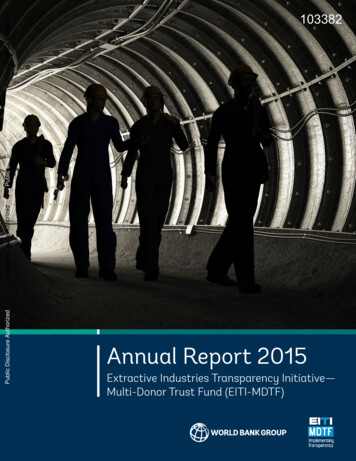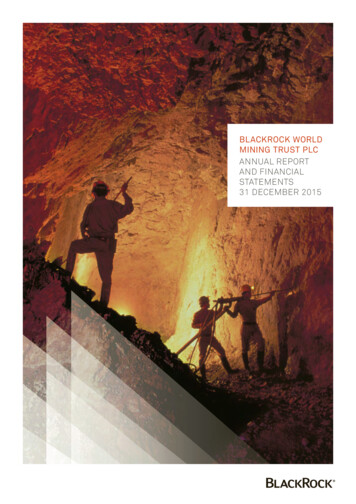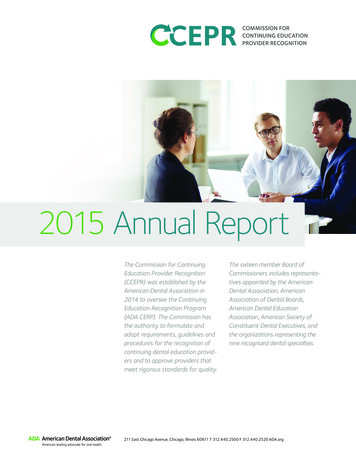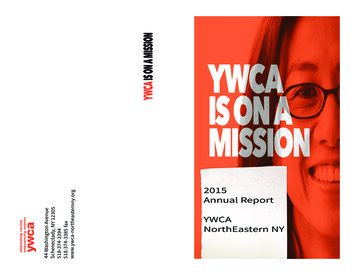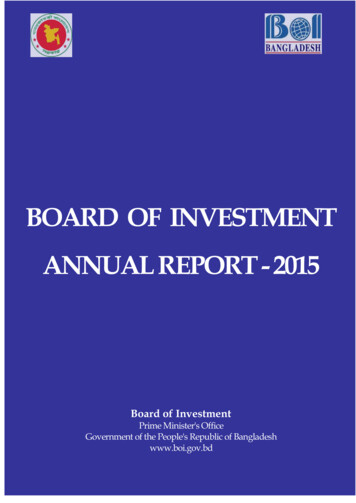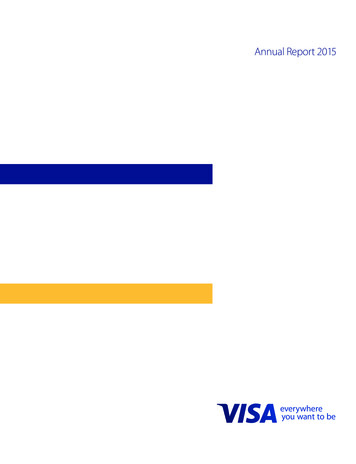
Transcription
Annual Report 2015
Financial Highlights ADJUSTED 1In millions (except for per share data)FY 2013FY 2014FY 2015Operating revenues 11,778 12,702 13,880Operating expenses 4,539 4,555 4,816Operating income 7,239 8,147 9,064Net income 4,980 5,721 6,438Diluted class A common stock earnings per share 1.90 2.27 2.62Financial Highlights GAAP In millions (except for per share data)FY 2013FY 2014FY 2015Operating revenues 11,778 12,702 13,880Operating expenses 4,539 5,005 4,816Operating income 7,239 7,697 9,064Net income 4,980 5,438 6,328Stockholders' equity 26,870 27,413 29,842Diluted class A common stock earnings per share 1.90 2.16 2.58Operational Highlights12 months ended September 30 (except where noted)2Total volume, including payments and cash volume2201320142015 6.9 trillion 7.3 trillion 7.4 trillionPayments volume 4.3 trillion 4.7 trillion 4.9 trillionTransactions processed on Visa's networks58.5 billion65.0 billion71.0 billionCards32.1 billion2.3 billion2.4 billionStock PerformanceThe accompanying graph and chart compares the cumulative total return onVisa’s common stock with the cumulative total return on Standard & Poor’s 500Index and the Standard & Poor’s 500 Data Processing Index from September 30,2010 through September 30, 2015. The comparison assumes 100 was investedon September 30, 2010, and that dividends were reinvested. Visa Inc.’s class Band C common stock are not publicly traded or listed on any exchange or dealerquotation system. 400 350 300 250 200Company/IndexVisa Inc.S&P 500 IndexS&P 500 DataProcessing Index123BaseperiodIndexed Returns(Fiscal Year 110.459/30/12183.63131.69156.84 .569/30/15389.74187.02297.45 1009/30/10 9/30/11 9/30/12 9/30/13 9/30/14 9/30/15Visa Inc.S&P 500 IndexS&P 500 Data Processing IndexFor further discussion of fiscal years 2015 and 2014 non-GAAP adjusted operating expenses, operating income, net income and diluted earnings per share, see Item 7 - Management’s Discussion and Analysis of Financial Condition and Results ofOperations - Overview - Adjusted financial results in this Annual Report. The per share amounts for the prior periods presented have been retroactively adjusted to reflect the four-for-one stock split effected in the second quarter of fiscal 2015.Total volume is the sum of payments volume and cash volume. Payments volume is the total monetary value of transactions for goods and services that are purchased on Visa-branded cards and payment products. Cash volume generally consists ofcash access transactions, balance access transactions, balance transfers and convenience checks. Payments volume for the 12 months ended June 30 is the basis for service revenue for the 12 months ended September 30. For further discussion, seeItem 7 - Management’s Discussion and Analysis of Financial Condition and Results of Operations - Overview - Nominal payments volume and transaction counts in this Annual Report.These figures represent data for the quarters ended June 30, 2015, June 30, 2014 and June 30, 2013.
A letter from our CEOCharles W. ScharfDear Shareholders,The payments industry is in the midst of thebiggest and most exciting changes it has everseen. The changes will ultimately result inbetter commerce experiences for consumers,faster growth at a lower cost for merchants, andcorresponding increases in economic growth.Like any period of change, there will bewinners and losers, and we are workinghard at Visa to ensure we are amongst thewinners.Before I go into specifics, I’d like tomake one comment which might seemstrange, but is nonetheless important.As our shareholders, you are entitled tounderstand our strategies and priorities.I will do my best to describe them here,but at the same time I am conscious of thefact that our industry is more competitivethan ever, and we need to be careful aboutbeing too specific if we think it could hurtour competitive position.2015 Performance2015 was another strong year for Visa.We reported adjusted earnings per sharegrowth of 16% and revenue growth of 9%in the fiscal full year. As has been the casefor several years now, we produced theseresults during a continued period of slowereconomic growth than we would hope tosee.We faced headwinds from the foreignexchange translation impact from thestrong U.S. dollar, reduced cross-borderpayments volume driven by the strongdollar, and the continuing drag of loweroil prices. Offsetting these were strongoverall payments volume growth, healthyprocessed transaction growth, and highcurrency volatility. All businesses have
headwinds and tailwinds in the short-term,and we are lucky to be part of an industrythat continues to have strong long-termgrowth potential due to the substantialunderlying growth rate for electronictransactions.While we know we have to deliver in theshort-term, we evaluate our own resultsbeing careful not to get caught in theshort-term earnings trap. We always askourselves if we are doing everything weneed to do to build the long-term valueof the franchise. We emphatically believethe answer is yes, but remain paranoid in ahealthy way. We also ask whether anythinghas changed about our views on growthbeyond the fiscal year. We continue tofeel great about our opportunity to driverevenue, earnings, and EPS growth for ourshareholders and know that the potentialto displace cash remains great, and that wehave more and better tools than ever toaccomplish this.Payments Industry LandscapeWe participate in one of today’s mostdynamic industries. When innovationoccurs in the payments business, theresults are material—creating a stepchange in how commerce works aroundthe world. The development of ournetwork was one such step change.People often think of the card as theinnovation, but the physical card wasjust the mechanism to access the realinnovation – the network—which providedthe ability to conduct and grow commercesafely and easily in partnership with ourclients worldwide. Through the years,there have been several products thathave used the network via cards: credit,debit, commercial, and prepaid products.Through these products, consumershave access to funds well beyond whatthey were comfortable carrying in theirpockets and have immediate access topre-approved credit lines. Conveniencehas been an important consideration, butthe safety that cards provided was also agreat step forward. The introduction ofzero liability in many markets around theworld meant that consumers could carryand use their cards without the risk of theft,as is still the case with cash. Visa’s productswere, and still are, also extremely costeffective compared to cash and checks formerchants.Today’s innovations hold the promise foran equivalent step change in convenience,safety, and growth in commerce. Asconsumers and merchants evolve toprefer digital first experiences, we aretransforming the company to embrace theopportunity that global connectednessprovides. The innovations we are seeingtoday fall into two categories. The first isprimarily around ways to access existingpayments networks and the second isaround the ability to create new paymentsnetworks themselves. Both of these aregreat opportunities for us, but also couldcreate risks as well. In addition, the wayin which we pursue these opportunitiesin the developed, developing, andunderdeveloped parts of the world are allvery different, but all are very meaningful.
New Network AccessE-commerce and M-commerce haveprovided both the need and the meansto move beyond physical cards and staticaccount numbers. These experiences cannow also meaningfully affect consumershopping behavior. We have to activelyensure our network is structured to bethe preferred network for those buildingexperiences in the E- and M-commerceworlds.Because of the huge opportunity,many—be they specific retailers, mobiledevice manufacturers, mobile networkoperators, social networks, search engines,or others—are working to integratepayments to further their own businessobjectives. Financial institutions (FIs) arealso working to ensure that they are notdisintermediated from their relationships,as third parties insert themselves intothe payments flow. At Visa, we areworking to bridge these worlds. WithoutFIs issuing our products and using ournetwork, we aren’t in the game, so wewill pursue opportunities which aresupportive of financial institutions. Thismeans we support partners who wantto use electronic payments to grow theirunderlying business while viewing theFIs and Visa as partners and encouragingconsumers to maintain and grow theirfinancial relationships with their FIs.This is sometimes easier said than done.The business world is filled with friendsand enemies and we need to differentiate.Those that support our network and ourFIs’ ability to maintain their customerrelationships, brand prominence, and riskmanagement protocols are our friendsand will be treated as such. There aremany examples here, including Google,Samsung, Square, and Stripe.New NetworksWe have faced competition from globaland regional networks for many years.Going forward, we expect new networksto continue to emerge. These includedistributed networks based on block chaintechnology and also payment alternativesthat use more traditional technologysolutions sponsored by governments,regulators, banks, and other paymentscompanies. To successfully compete, weneed to continue to ensure our network issafe, convenient, and reliable. We also needto continue to innovate in order to ensurewe have the most value-added featuresand benefits of any network. Examples ofrecent innovations include: Launched new APIs that make it easierfor developers to connect to Visa andget faster access to our capabilities Enhanced our predictive risk modelinginfrastructure Created new mobile and biometricauthentication capabilities Developed analytic solutions that helpmore quickly identify breached entities Launched Visa Integrated MarketingSolutions, a card marketing platformdesigned to help small to medium-sizedissuers optimize their marketing efforts Created the Visa Commerce Network,a new way for merchants to grow theirbusiness through relevant consumeroffers Piloting Rewards Redemption, a newproduct which allows consumers touse their participating issuer or loyaltyprogram rewards points towardpurchases at participating everydayspend merchants Providing a range of new data andanalytic capabilities delivered by over1,200 Visa engineers and analysts
The Global OpportunityVisa EuropeIn November, we were delighted toannounce that we signed a definitiveagreement to acquire Visa Europe. VisaEurope is the only regional associationwhich didn’t merge into Visa Inc. in 2007and remained a separate entity ownedby its members. We have been clear thatthis was a transaction that we thoughtmade tremendous sense for our companyand also for Visa Europe and its members,so we are thrilled with the prospect ofmoving forward as one company.Financial TermsWe will acquire Visa Europe for an upfront consideration of 16.5 billion eurosconsisting of 11.5 billion euros in cashand convertible preferred stock valuedat 5 billion euros. In addition, VisaEurope member-owners will potentiallyreceive an earn-out payment of up to4.0 billion euros and 0.7 billion eurosin interest. This earn-out will be basedon the achievement of net revenuetargets during the 16 fiscal quartersfollowing the closing of the acquisitionand provides additional upside to bothparties if those agreed targets are met.It will be payable following the fourthanniversary of the transaction close.We believe the transaction is financiallyattractive for both parties, with abalanced consideration of a mix of cash,stock and an earn-out. We expect it tobe accretive to our stand-alone revenueand EPS growth before transition costsbeginning in FY17, the first full year ofthe combination.The preferred shares offer currentVisa Europe members a continuingownership stake in the companyand also serve to provide liabilityprotection to our Visa Inc. shareholdersin conjunction with a new loss sharingagreement with key UK banks. The earnout provides additional upside potentialfor both parties if net revenue targetsare achieved. We feel the balancedconsideration encourages Visa Europe’scurrent owners and Visa Inc. to worktogether to enhance the long-termvalue of the business to the benefit of allparties.Strategic ImportanceCombining Visa Inc. and Visa Europe isstrategically important for both of us.We believe the combination will createsignificant benefits for both Europeanand Visa Inc. global clients. Our clientswill benefit as we work every day toearn their business, bringing them At the initial conversion rate, the shares of Visa Inc. preferred stock issued in the transaction will be convertible into an aggregate of 78,654,400 shares of class A common stock, valued at approximately 5.0 billion based on the average tradingprice of the class A common stock of 71.68, and the average Euro/Dollar exchange rate of 1.12750, each for the 30 trading days ended October 19, 2015. The acquisition is subject to regulatory approvals.
We are thrilled with the prospect of movingforward as one company.the full power of our global platform,innovative products and services andworld-class brand. The transaction willprovide European clients with directaccess to our investments in technology,differentiated products and services,capital and talent. We will also prioritizeEuropean client needs in the allocationof our resources and we believe wecan deliver a stronger set of digitalcapabilities than would be possiblewithout this combination.Importantly for Visa Inc., this transactionwill create a truly integrated globalleader and will allow us to capitalize onstrong growth opportunities in a highlyattractive region. We expect that it willcreate substantial value through revenueopportunities and cost efficienciesassociated with the transition froma member
Operations - Overview - Adjusted financial results in this Annual Report. The per share amounts for the prior periods presented have been retroactively adjusted to reflect the four-for-one stock split effected in the second quarter of fiscal 2015. 2 Total volume is the sum of payments volume and cash volume. Payments volume is the total monetary value of transactions for goods and services that are
